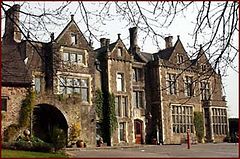Miskin Manor

The origins of Miskin Manor can be traced back to at least the early medieval period, when its lands were held by Nest, daughter of the Prince of Glamorgan, in the late 11th century. Records from the mid-16th century make mention of “Miskin gate,” suggesting a house of some stature occupied the site at that time.
By 1610, the manor had passed into the hands of a branch of the Bassett family of Old Beaupre, remaining with that noble line until 1857 when it was sold to David Williams, a prosperous coal owner. Williams, renowned as the celebrated Welsh bard “Alaw Goch,” was also a passionate supporter of Welsh culture through his support of the National Eisteddfod movement.
He reconstructed and expanded the manor house in 1864, enlisting the prominent architect David Vaughan of Bridgend. The neo-Jacobean style manor incorporated elements of the earlier 16th/17th century dwelling, its irregular plan and varying wall thickness betraying its Medieval antecedents.
Under Williams’ son, the esteemed Judge Gwilym Williams, whose wife Emma coincidentally was a descendant of Nest, further improvements were made to the estate.
Miskin Manor entered its cultural zenith under the tenure of Sir Rhys Williams in the early 20th century. A hive of fashionable society life, the manor even hosted the future Edward VIII during one of his tours of Wales in the 1920s. Tragedy struck in 1922 when a devastating fire ravaged the interior, virtually only leaving the external walls intact.
In 1940, with Britain embroiled in the Second World War, Miskin Manor was used by the Red Cross as a convalescent hospital transferring to the NHS in 1948. Lady Williams herself served as commandant during the war and continued to live here until 1955.
The manor was again partially consumed by flames in 1952 before being subdivided into post-war flats.
The current chapter in Miskin’s chronicle began in 1985 when the estate was sold and converted into a country house hotel, preserving its rich architectural heritage for future generations to admire.
The manor, and many of the features within its walled garden have been listed as Grade II since 1976, for having ‘architectural interest as a large 19th century Tudor-Gothic country house retaining original character and detail’
For more information about the history of the community of Pontyclun please visit our online museum